Polypropylene (PP) plastic is one of the most versatile and widely used polymer materials worldwide. It has earned its reputation for being highly durable, flexible, and resistant to heat and chemicals. This has made it a preferred choice in numerous industries, including packaging, automotive, medical, and even consumer goods. So, what exactly makes polypropylene so crucial for modern manufacturing? This article aims to address the question by illuminating the science behind PP plastic, its distinctive properties, and its diverse applications.
What are the Properties of Polypropylene?

Polypropylene (PP) is a versatile thermoplastic polymer known for its balanced mechanical, thermal, and chemical properties. Key properties include:
- Durability: PP offers excellent impact resistance and is less prone to stress cracking, making it ideal for demanding applications.
- Lightweight: With a low density, PP is both lightweight and strong, making it suitable for use in packaging and the automotive industry.
- Chemical Resistance: It is highly resistant to many acids, bases, and organic solvents, ensuring longevity in harsh environments.
- Thermal Stability: PP has a high melting point (approximately 130–170°C), making it suitable for applications requiring heat resistance.
- Flexibility and Moldability: Its ability to be easily molded and shaped without compromising structural integrity enables the creation of complex product designs.
- Cost-Efficiency: Due to its low manufacturing cost, PP is a popular choice in cost-sensitive industries.
These properties collectively make polypropylene a widely used material across various sectors, including packaging, construction, and healthcare.
Understanding the Chemical and Physical Properties of PP
Due to its exceptional combination of both chemical and physical properties, polypropylene (PP) is highly versatile in commercial and industrial applications. Chemically, PP has a broad resistance to various acids, bases, and organic solvents, ensuring reliability and durability when coming into contact with harsh materials. Its non-polar character bestows excellent chemical inertness, which is crucial for containers and piping systems that are exposed to reactive chemicals over a long period. Besides, its low moisture absorption has proven PP to be beneficial in regions with fluctuating humidity levels.
From a physical standpoint, PP is known for its outstanding thermal stability, as it has a melting point of roughly 160-165°C. Moreover, it has been noted to have greater than average tensile strength and remarkable impact resistance, enabling it to endure mechanical stress without deforming. The material also has low density, which allows for use in lightweight applications without compromising strength. This, along with its recyclability and environmental resilience, guarantees that polypropylene remains a critical material in industries where performance, adaptability, and cost efficiency are of high importance.
Density and Melting Point of Polypropylene
The density of polypropylene is around 0.895 to 0.92 g/cm³, making it one of the lightest industrial polymers. Its low-density polypropylene contributes to reducing material weight while preserving structural strength. The melting point of polypropylene typically ranges from 130°C to 171°C, depending on the degree of crystallinity and isotacticity. This higher-than-average melting point improves thermal stability, making polypropylene usable in industries that require heat resistance, such as automotive, packaging, and textiles.
Mechanical Properties of Polypropylene Plastic
Across different industries, polypropylene offers an exceptional blend of mechanical properties, which improves its overall value. It has a high tensile strength of 30 to 40 MPa, allowing polypropylene to sustain greater levels of stress. Moreover, its elasticity, represented by the modulus of elasticity, which is usually between 1300 and 1800 MPa, enables this material to bend without breaking and hence efficiently bear dynamic loads and vibrations.
The material exhibits excellent impact resistance, particularly above freezing, which is crucial for optimal performance under load or shock. At subzero temperatures, however, polypropylene’s impact resistance gives way due to increased stiffness in the material.
Also, as mentioned above, polypropylene has a relatively low density of 0.89 to 0.91 g/cm³, which contributes to the material’s desirability in the automotive industry. Furthermore, the lightweight nature is highly advantageous in both packaging and automotive manufacturing. Its surface hardness is moderate, ranging from 50 to 70 on the Shore D scale. Thus, it is scratch-resistant while remaining flexible. Polypropylene’s remarkable resistance to fatigue also makes it worthwhile in many products that are subject to repeated motion, such as the hinges of plastic containers.
What are the Different Types of Polypropylene?
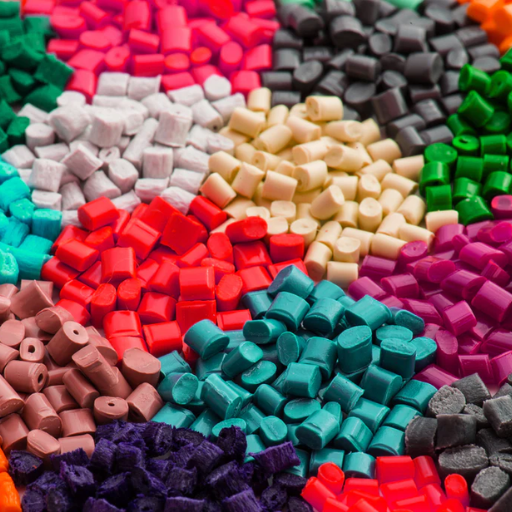
Polypropylene can be categorized into three main types:
- Homopolymer Polypropylene
This is the most common type of polypropylene, consisting of only propylene monomers. It is valued for its excellent strength-to-weight ratio, stiffness, and resistance to high temperatures, making it suitable for applications like packaging, textiles, and automotive components.
- Copolymer Polypropylene
Copolymer polypropylene incorporates small amounts of other monomers, such as ethylene, to improve impact resistance and toughness. It is often used in applications that require durability and flexibility, such as storage containers, piping systems, and household items.
- Random Copolymer Polypropylene
This variation includes randomly distributed ethylene within the polymer chain. It has enhanced clarity, flexibility, and low-temperature impact resistance, making it ideal for applications such as food packaging and medical products.
Polypropylene Homopolymer vs. Copolymer
Of critical importance is the selection process when considering Polypropylene homopolymer (PP-H) and polypropylene copolymer (PP-C) together, due to the differences in their composition, mechanical properties, and suitability for applications.
Structural components, such as industrial parts, automotive components, and textiles, benefit from PP-H’s higher strength and rigidity, which stem from its sole composition of propylene monomers. Its resilience and performance foster reliability. However, environments with sub-zero temperatures are problematic. The material’s low flexibility, impact resistance, and rigidity prove detrimental when adaptability is a requirement.
Due to its elasticity, adding comonomers like ethylene makes PP-C more advantageous than its counterpart. Block copolymers are categorized under this due to their sturdy durability and excellent rigidity characteristics. This makes them ideal for piping systems and automotive bumpers. With enhanced clarity and softness, random copolymers prove more beneficial for consumer goods and medical devices.
When choosing materials, one should pay attention to operational temperature ranges, exposure to elements, and their performance reliability. Alongside these factors, the softening point helps determine the suitability of the materials when measuring their tensile strength, impact resistance, and flexing attributes.
Applications of Various Types of Polypropylene
The numerous industries that use polypropylene as a construction material can do so due to the various grades and types it offers. The robust construction of rigid units, such as refrigeration boxes, automotive interiors, and industrial apparatus, makes ample use of homopolymers because they are inflexible yet possess high internal strength. Aside from those, they are also used in textiles and fibers because they are durable and can be processed easily.
For softer and lighter work where temperature sensitivity and good optical transparency are essential, such as in the food packaging industry or medical-grade syringes, random copolymers work best because they are more transparent and flexible. They are also more suitable for hygiene breathable films used in sanitary items.
Block copolymers are ideal for use where good impact resistance is required, such as in automotive bumpers, heavy-duty crates, and storage containers that undergo severe mechanical stress. They help enhance the longevity of the items and provide them with considerable protection from wear and tear.
Furthermore, cultivation tools like greenhouse coverings require high-grade, UV-stabilized material for eye protection, alongside electric fixture housings, which require flame-resistant features. These show that advancements in polypropylene fabrication help achieve high-performance features while meeting the growing needs of the industrial spectrum.
Comparing Polypropylene to Other Commodity Plastics
Compared to other plastics, such as polyethylene (PE), polyvinyl chloride (PVC), and polystyrene (PS), polypropylene (PP) has several advantages that make it widely applicable.
In comparison to polyethylene, PP has greater tensile strength and is far more heat-resistant. This allows for its use in areas that require a great deal of mechanical functioning as well as thermal stability. Concerning PVC, PP is non-chlorinated. This provides no concerns regarding dioxin emissions during production or disposal, making it an option for environmentally centric use cases. Furthermore, PP has a greater impact resistance than PS. This means it is better at withstanding mechanical deformation when placed under stress or additional forces.
PP has a significant advantage over its competitors because of its extremely low density. It helps improve the weight-to-performance ratio due to its suitability for car components, lightweight packaging, and other areas where mass needs to be reduced. While all other plastics are required in specific scenarios, PP is superior due to its ability to balance endurance, resistance, and flexibility in high-performance applications.
How is PP Plastic Recycled?
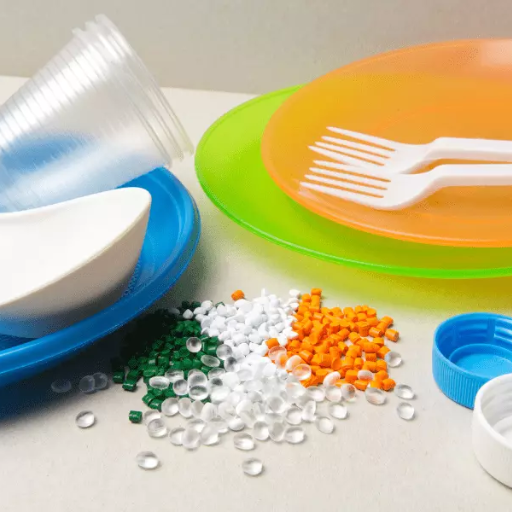
Recycling polypropylene plastic (PP) involves a specific process that consists of several steps. It begins with collecting, sorting, and cleaning PP products to remove any unwanted contaminants, such as food leftovers and labels. After washing, the plastic is shredded into smaller particles to aid in processing. The pieces are eventually melted and reprocessed into pellets, which act as raw materials for the fabrication of new products. Recycled polypropylene (PP) is typically found in containers, automotive parts, and various types of textiles. Despite the steps taken to reduce waste, the rate of polypropylene recycling remains low compared to other plastics.
The PP Recycling Process Explained
PP plastic can be recycled through a series of clearly defined steps. These can include everything from collection to shredding, cleaning, sorting, and reprocessing for repurposing. In collection and sorting, PP items are grouped with other types of plastic and waste materials. There is an increase in the use of sorting technologies that use advanced infrared sensors and AI-based systems to enhance accuracy. After sorting, food residues, oils, and labels, also known as contaminants, are cleaned to improve the quality of the recycled end product.
The polypropylene undergoes additional washing after it is initially cleaned and shredded into small pieces. These pieces undergo a controlled melting process to ensure they are heated to an ideal temperature, which maintains the material’s integrity and prevents degradation. Once molten, the polypropylene is cooled to form pellets, which become the raw material for new products. These pellets undergo rigorous quality testing, being assessed for performance and reliability, before being utilized in the creation of packaging, construction, and automotive parts.
Although progress has been made in recycling technologies, efficiency obstacles such as high contamination rates and mixed plastic streams pose a significant challenge. Enhanced mechanical recycling processes and new methods of chemical recycling have the potential to increase the global polypropylene recycling rate, showcasing bold new solutions to these challenges. Optimizing plastic waste collection systems, implementing container deposit schemes, and educating the public also play a vital role in advancing the circular economy for polypropylene.
Benefits of Recycling PP Plastic
There are many benefits of recycling polypropylene (PP) plastic, which fall under environmental, economic, or industrial categories. For instance, recycling PP plastic reduces the need to extract virgin plastics from fossil fuels, for producing plastics, as PP waste materials are repurposed. This also helps in mitigating greenhouse gas emissions. Further, by recycling PP, there is a reduction in the volume of plastic waste sent to landfills, which endorses better waste management techniques. On top of that, pollution is decreased. Recycled PP also has economic benefits, as it provides industries with cost savings, since PP feedstock materials are cheaper than virgin plastics. There are also advances in recycling technologies that allow PP to meet the high demands of the automotive, construction, and consumer goods industries. Recycling also supports the circular economy by conserving resources and keeping materials in use. Research suggests that increasing PP recycling rates will not only have a positive impact on the environment but also help reduce the environmental footprint of the polypropylene plastic. In addition, more job opportunities are being created in waste and recycling management services.
Challenges in PP Recycling
Recycling polypropylene (PP) is technically complex and logistically challenging, which makes it inefficient and difficult to scale. One main problem is sorting, where PP is sampled from a mixed plastic stream. Identifying PP using sophisticated sorting technologies, such as near-infrared (NIR) spectroscopy, requires accurate determination of PP, but their implementation is expensive and not universally available. Moreover, contamination from food residues, non-recyclable additives, and adhesives further degrades the quality of recycled PP, limiting its use in high-demand industries.
PP polymer composition also presents another challenge. With every form of PP comes its specific set of Additives, fillers, and dyes, which introduce molding-altering consistency within the molecular structure. This inconsistency leads to lower mechanical properties and performance in the recycled PP, requiring it to undergo advanced chemical recycling processes, such as depolymerization, which breaks down polymers into monomers, allowing for the construction of virgin materials. Still, chemical recycling remains expensive and energy-inefficient, limiting its use.
Finally, the lack of proper facilities affects the usage of PP recycling. In many areas, collection systems and facilities for processing PP are not available. In addition, the level of knowledge about the recyclability of PP is relatively low, which leads to the improper disposal of PP products and exacerbates the problem of landfills. Solving such problems requires integrating policies, technology, consumer education, and other strategies to create a more powerful and sustainable recycling system.
What are the Applications of PP Plastic?
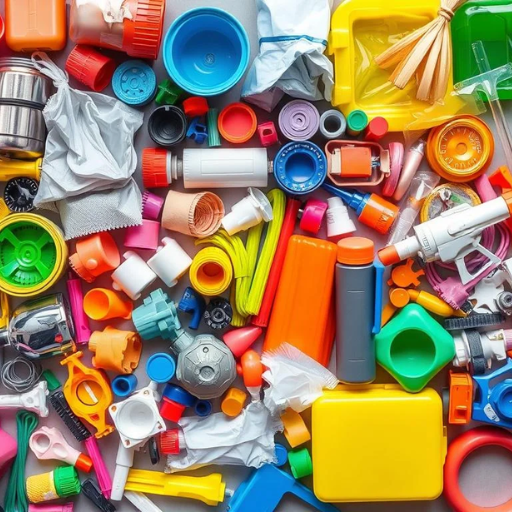
Polypropylene (PP) plastic is widely used across various industries due to its durability, lightweight nature, and resistance to chemicals. Key applications include:
- Packaging: Commonly used for food containers, bottle caps, and flexible packaging due to its moisture barrier properties.
- Automotive Components: Used in car bumpers, battery cases, and interior trim owing to its strength and impact resistance.
- Textiles: Found in fibers and fabrics for items like carpets, upholstery, and reusable bags.
- Medical Products: Utilized in syringes, vials, and medical-grade containers because it can be sterilized effectively.
- Consumer Goods: Applied in household items such as storage bins, toys, and appliance components.
These applications highlight the versatility and functionality of PP plastic across multiple domains.
Use of PP in Packaging Materials
The high-quality mechanical and physical properties of Polypropylene (PP) have made it a vital element in the packaging industry. From containers and bottles to caps and pouches, it is extensively used for both rigid and flexible packaging solutions. PP is well-known for being lightweight, highly resistant to chemicals, and maintaining its structure under various temperature conditions. As of now, PP is a dominant polymer in the global market due to its recyclability, cost efficiency, and sustainable packaging efforts, which, along with these, make it a material of choice. Furthermore, polymer engineering improvements have enhanced the barrier properties of PP, thereby increasing the polymer’s ability to shield delicate food and pharmaceutical products from moisture, oxygen, and contamination. Such features make it essential across many sectors, including food, beverages, and healthcare, where safe, durable, and economy-friendly packaging is highly valued.
Automotive Applications of Polypropylene
Due to the exceptional durability, low cost, and lightweight properties of Polypropylene (PP), it has gained usage in the automobile industry. Its low density enables further weight reduction in vehicles, which optimizes fuel consumption and minimizes emissions. PP is commonly used in manufacturing bumpers, battery cases, interior panels, and dashboard components due to its thermal stability and impact resistance. Bumpers and battery cases made of PP can withstand screws and high temperatures without losing shape.
With the development of new polymer technologies, reinforced grades like glass-fiber-reinforced polypropylene have been added to the growing family of polypropylene. The latest materials are safer and more reliable for use in automobiles because they are more rigid and stronger. PP is also readily recyclable, making it favorable in the growing markets and aligned with the environmental standards governing the automobile industry.
Medical Applications of PP Plastic
PP, or polypropylene, is used heavily in medicine due to its chemical compatibility, strength, and biocompatibility. The high resistance to degradation that PP offers when subjected to sterilization methods, such as autoclaving, makes it valuable in medicine. It is widely used in the production of surgical instruments, syringes, IV bottles, and even implantable devices. Its low chances of chemical leaching also make it suitable for storing pharmaceuticals and biological fluids, ensuring patient safety. Moreover, the healthcare industry has new requirements that are now being met due to evolving technologies that offer higher strength, transparency, and other features, such as advanced medical-grade polypropylene. With all these qualities, PP greatly helps extend shelf life, fulfill stringent regulatory requirements, reduce contamination, and uphold safety guidelines in the medical field.
What are the Benefits of Using PP Plastics?
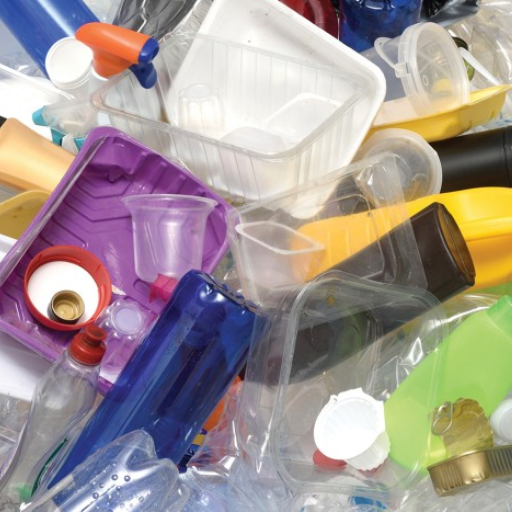
The use of plastics like Polypropylene (PP) is extremely useful in the medical industry due to its being lightweight yet strong, cost-effective, easy to customize, and enabling mass production when needed. Also, PP has high durability and is resistant to a variety of chemicals. It can easily be used in sensitive areas since it is safe and hygienic due to its resistance to sterilization.
Heat Resistance and Chemical Resistance of Polypropylene
Having both heat and chemical-resistant properties makes PP extremely useful in industrial settings. It is ideal for use with rotating equipment because it can withstand high operating temperatures, having a melting point between 130°C and 170°C (266°F and 338°F). Withstanding and performing well in industrial processes such as Microwaving, injection molding, extrusion, and microwaveable containers makes PP a versatile material.
In terms of chemical resistance, polypropylene can tolerate a variety of chemicals. It is a polymer that can withstand acids, solvents, and bases, making it worthwhile for use in chemical processing, storage tanks, and laboratory instruments. Moreover, polypropylene continues to maintain its mechanical strength properties after long-term exposure to these chemical environments, assuring dependability and durability in harsh conditions.
The use of polypropylene in medical devices and food contact packaging is attributed to its inertness towards most chemicals, hence providing safety. These dual factors still make polypropylene one of the engineering polymers used in various chemical and heat processing industries.
Good Impact Resistance of PP Plastic
Polypropylene (PP) plastic is known for its superior resistance to impact, making it beneficial in applications where mechanical stress is encountered. The reason behind this is the semi-crystalline nature of PP, which provides resistance to breaking upon impact and also enables the material to absorb and disperse energy. Research proves that PP is valid in both high and low temperature settings while maintaining impact resistance.
Impact-modified polypropylene blends are more mechanically resilient and reliable in the automotive sector for parts like bumpers and dashboards, which experience repeated impacts without permanent deformation or fracture. Similarly, PP’s reliability in load-bearing tasks is unmatched in packaging solutions where storage containers and boxes need enduring, sturdy protection against mishandling and drops. The impact resistance of PP can be further improved by using advanced additives and copolymers to tailor the property modifications optimally for different industry requirements.
Cost-Effectiveness of Polypropylene for Manufacturers
Polypropylene (PP) is listed as one of the cheapest materials available to manufacturers owing to the low costs, ease of processing, and favorable value offered compared to the price. The processes used to obtain PP make it economical due to the abundant and easily accessible raw materials fed into the system through the polymerization of propylene monomers. Along with this, the lower density of thermoplastics, even polypropylene (PP), compared to a significant fraction of other polymers, offers unparalleled value due to lower material costs without affecting strength.
From an operational perspective, the characteristics of polypropylene align well with current manufacturing methods, such as injection molding and extrusion. These processes allow for larger quantities of production at a lower cost per unit, which is ideal for industries that require scalability, such as the automotive, consumer goods, and packaging sectors. Moreover, its recyclability presents additional economic savings. Recycling polypropylene saves on the cost of materials needed, thereby reducing expenses, and also increases sustainability, a huge marketing factor in the current economy.
How Does Polypropylene Compare to Other Plastics?
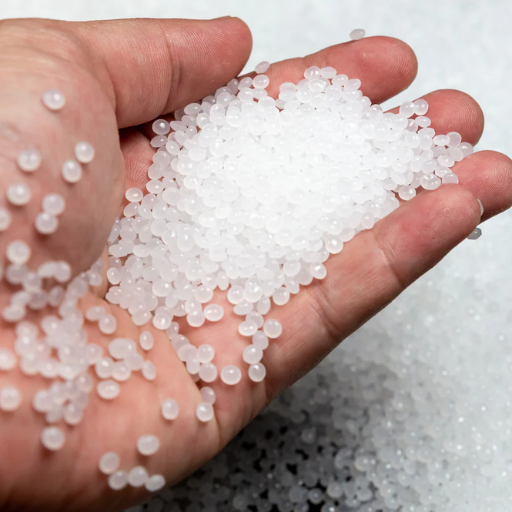
PP is gaining preference among other plastics, due to its strength, flexibility, and low price. With a greater melting point than polyethylene, PP is suited for heat-resistant applications. It is also lighter than PVC, allowing it to be used in strong yet lightweight products. Unlike polystyrene, PP’s impact strength and lesser brittleness provide added benefits in a multitude of industries. Furthermore, polypropylene’s high recyclability makes it a more sustainable alternative than other plastics. These features enable it to possess cross-industry utility, which PP is making use of.
Properties of Polypropylene Compared to Polyethylene
Having numerous similarities, polypropylene (PP) and polyethylene (PE) also possess unique features that serve them in particular use cases. Their melting point is one of the key differences between the two. High density polyethylene (HDPE) has a melting point range of 105-115°C, while PP’s is significantly higher at 130-160°C. Sterilization processes, such as those used in medical equipment or food containers, are better suited for polypropylene (PP).
Polypropylene tends to have superior rigidity and tensile strength compared to polyethylene from a mechanical perspective. This means that PP can be used in products that undergo significant mechanical strain, such as automotive parts or piping systems. On the other hand, polyethylene, especially in its low-density form (LDPE), is much more flexible and far more resistant to stress cracking, making it better suited for applications such as plastic bags and film.
Moreover, PP is considered the better option for living hinges since it resists fatigue and bending much more effectively than other materials. In contrast, polyethylene is more chemically inert and has better impact resistance at lower temperatures, which makes it suitable for extreme cold or chemical environments.
Performance of PP in Different Environmental Conditions
Based on the chemical and physical properties of Polypropylene (PP) plastic, it has remarkable features even under extreme conditions. From a structural point of view, PP plastic has high mileage and flexibility; it’s also capable of withstanding around 100 degrees Celsius, with an impressive melting point of around 160 degrees Celsius. This degree of thermal resistance is highly advantageous for devices like hot-fill containers and automotive components.
PP plastic is prone to becoming brittle at low temperatures due to its semi-crystalline structure. However, tertiary prevention strategies, such as incorporating copolymers and additives, have dramatically improved impact performance at low temperatures, allowing for enhanced usability in colder climates. Moreover, PP has a remarkable capacity to endure harsh chemicals, including a wide range of solvents, acids, and bases, making it ideal for industrial and laboratory environments.
The most notable advantage of PP plastic is its weight, making it very user-friendly when working with or transporting it. PP plastic can be exposed to UV rays; however, avoiding prolonged exposure will help prevent it from weakening and discoloring. This is the most notable downside of the product. In general, PP plastic’s remarkable ability to withstand abuse while maintaining performance makes it highly valuable in the automotive and engineering industries, paving the way for new construction technologies.
Why Choose PP Over Other Thermoplastics?
For a long time, polypropylene (PP) has maintained its position as a top-tier thermoplastic due to its favorable properties and relatively low cost. Its high strength-to-weight ratio facilitates its easy integration into packaging and automotive parts, two industries where every ounce of material saved translates to significant value. In addition, PP’s resistance to chemicals is greater than that of many other plastics and remains stable when exposed to acids, alkalis, and organic solvents. This makes polypropylene ideal for medical equipment, chemical storage, and piping applications.
PP’s versatility is contributed to by its excellent processability. It provides flexibility in manufacturing methods, such as injection molding, extrusion, and blow molding, which makes it possible to produce complex shapes and designs while drastically reducing waste. In addition, the thermal stability of PP allows it to withstand a wide range of temperatures, from hot to cold, without losing its mechanical properties. Its robust stiffness in subzero temperatures, along with its competitive price point, creates value compared to other plastics like polyethylene (PE) and acrylonitrile butadiene styrene (ABS), which do not offer the same range of features.
Reference Sources
-
Investigation of the impact, hardness, density and water absorption of polypropylene filled Doum palm shell particles composite
This study examines the mechanical and physical properties of polypropylene composites reinforced with Doum palm shell particles. Using a compression molding method, the research highlights the effects of particle loading on impact resistance, hardness, density, and water absorption. -
Thermal degradation of polypropylene reprocessed in a co-rotating twin-screw extruder: Kinetic model and relationship between Melt Flow Index and Molecular properties
This paper investigates the thermal degradation of polypropylene during reprocessing. It develops a kinetic model to understand the relationship between the Melt Flow Index (MFI) and molecular properties, providing insights into the material’s behavior under repeated processing. -
A study of plastic waste management effectiveness in Indonesia industries
This research discusses the properties of polypropylene as a thermoplastic that can be easily formed at high temperatures. It also explores its role in recycling and waste management practices in industrial settings. - Top PP Plastic Pellets Suppliers in China
Frequently Asked Questions
Q: What is polypropylene plastic?
A: Polypropylene plastic, commonly referred to as PP, is a type of polymer that is widely used due to its versatility and excellent material properties. It is a popular plastic known for its strength, lightweight nature, and resistance to chemical and thermal degradation.
Q: What are the main applications of polypropylene plastic?
A: Polypropylene plastic has a variety of uses, including in food packaging, automotive components, plastic bottles, and engineering plastics. Its properties make it an ideal material for both consumer and industrial applications.
Q: How does polypropylene compare to polyethylene?
A: Polypropylene and polyethylene are both popular plastics, but polypropylene has better mechanical and chemical properties. For example, polypropylene is more resistant to fatigue and has a higher melting point than polyethylene, making it suitable for a broader range of applications.
Q: What are the benefits of using polypropylene in food packaging?
A: The benefits of PP in food packaging include its excellent barrier properties, resistance to moisture, and ability to be sterilized. These characteristics help maintain food safety and extend shelf life, making them a preferred choice for food containers.
Q: What are the material properties of polypropylene plastic?
A: The material properties of polypropylene include excellent mechanical properties, high chemical resistance, low density, and good electrical properties. These attributes make it a versatile plastic suitable for various applications.
Q: Can polypropylene plastic be recycled?
A: Yes, polypropylene plastic can be recycled. However, the recycling process for PP is not as widespread as for other plastics, leading to challenges with plastic waste. Efforts are being made to improve recycling rates and reduce the environmental impact of plastic products.
Q: What is expanded polypropylene and where is it used?
A: Expanded polypropylene (EPP) is a lightweight foam material made from polypropylene. It is used in applications such as packaging, automotive parts, and insulation due to its excellent shock absorption and durability.
Q: How is polypropylene plastic made?
A: Polypropylene plastic is made through the polymerization of propylene monomers. This process involves chemical reactions that create long chains of polymer, resulting in a material that exhibits the desired mechanical and chemical properties.
Q: What role does polypropylene play in the automotive industry?
A: In the automotive industry, polypropylene is utilized for manufacturing various plastic parts, including interior components, bumpers, and instrument panels. Its lightweight nature and durability help improve fuel efficiency and overall vehicle performance.


